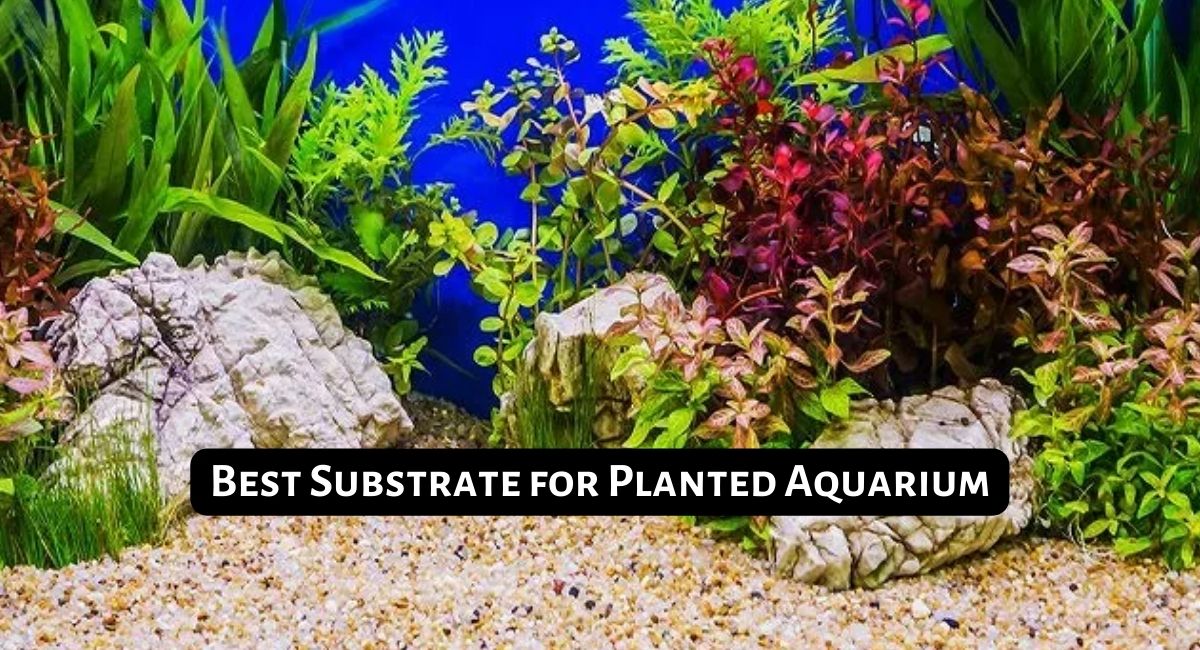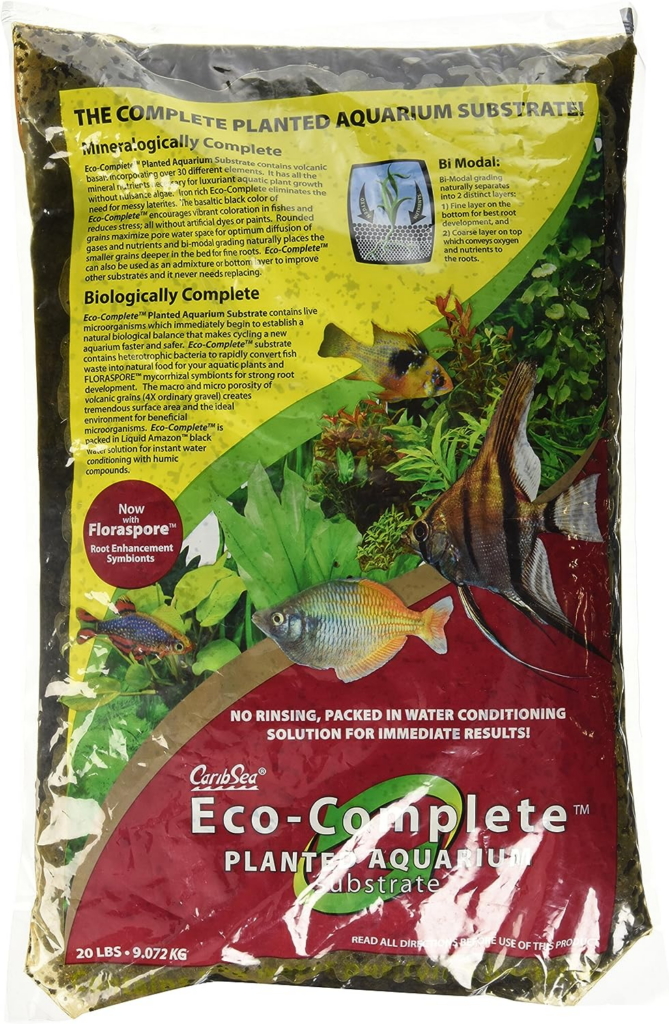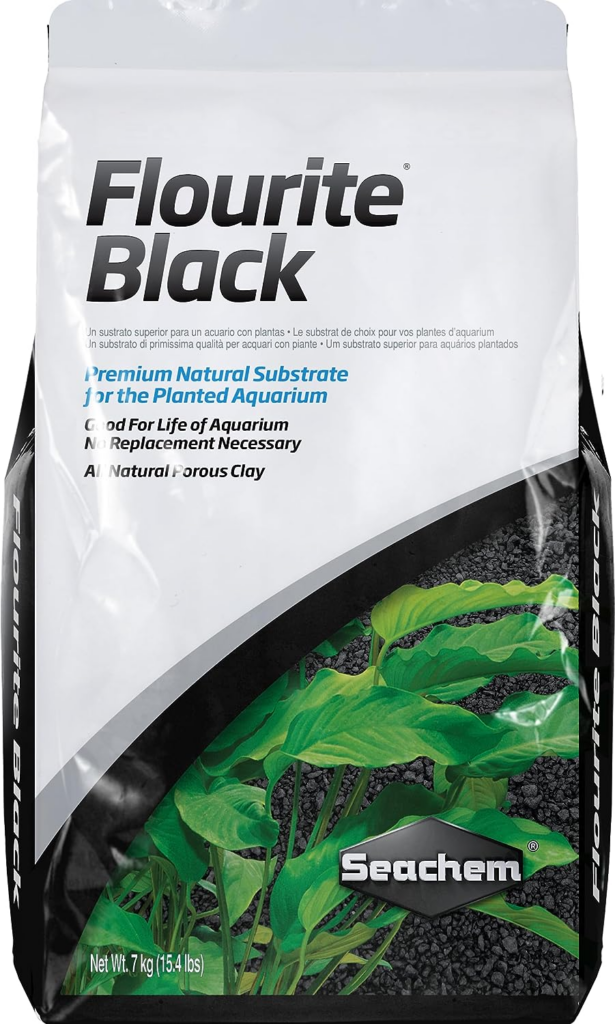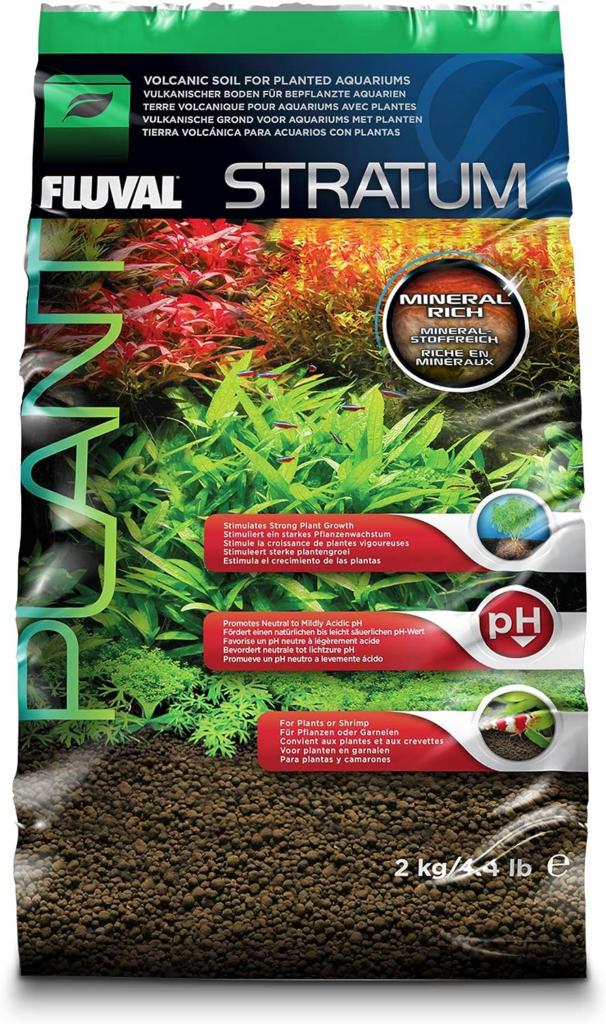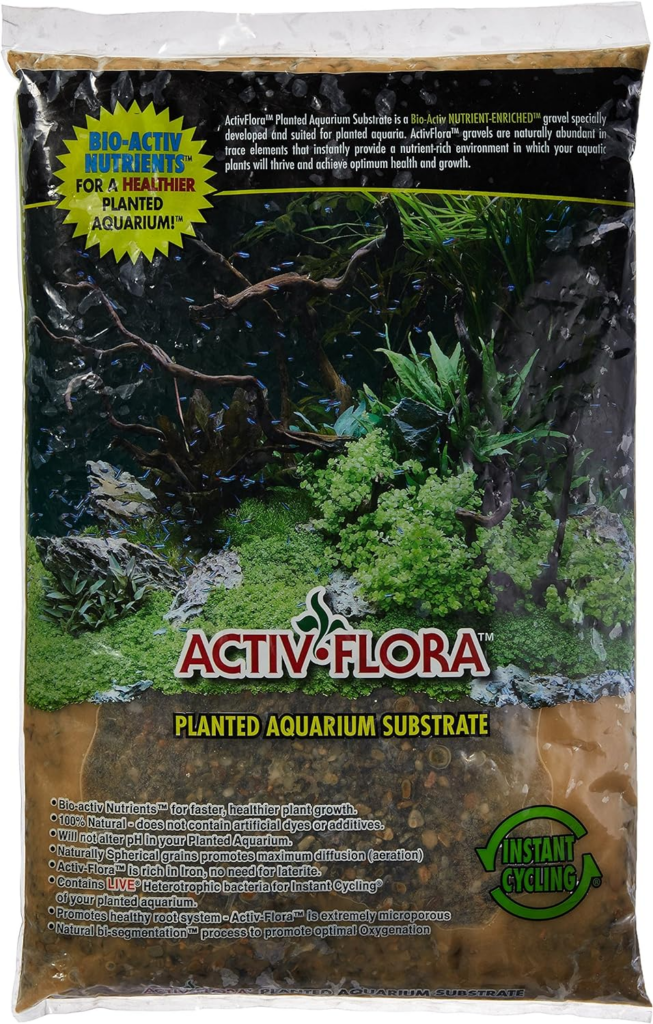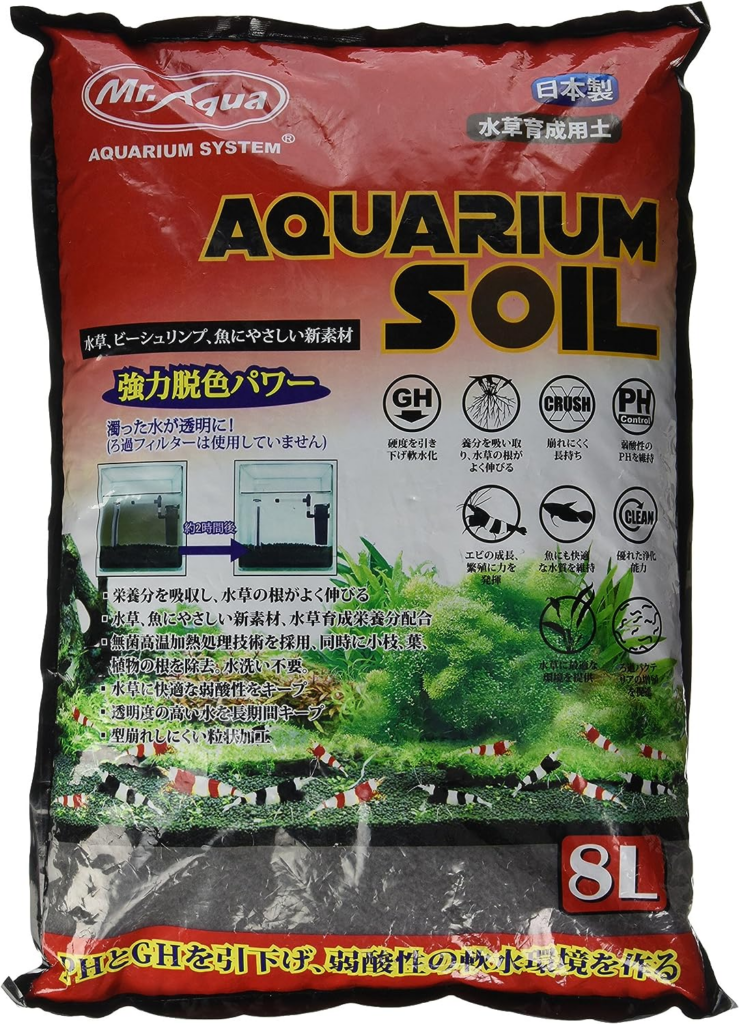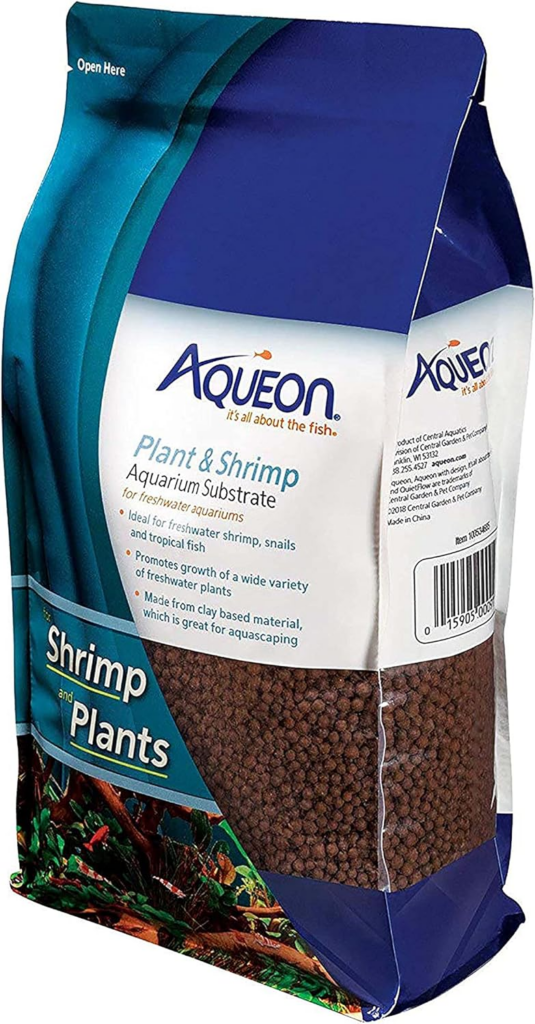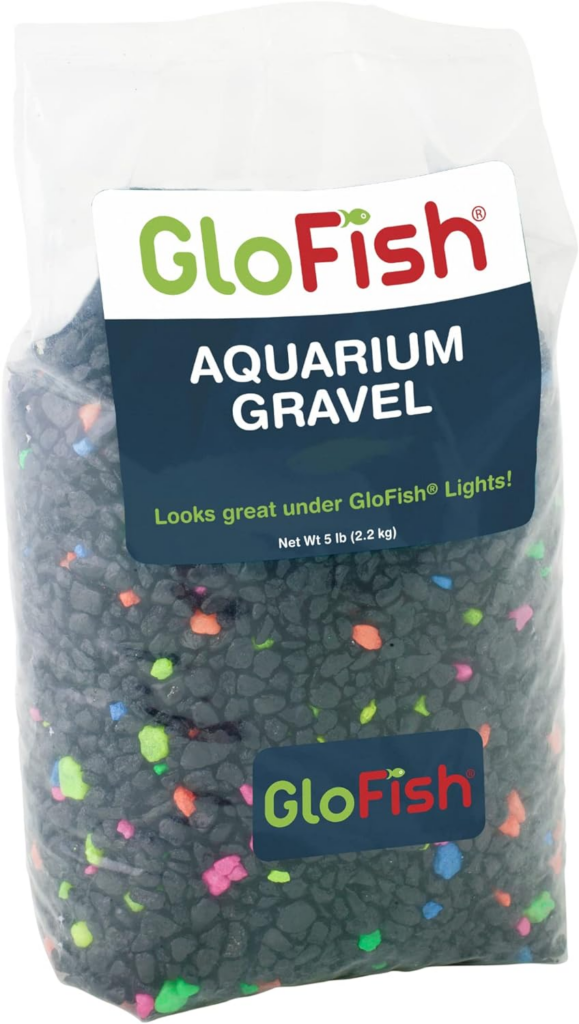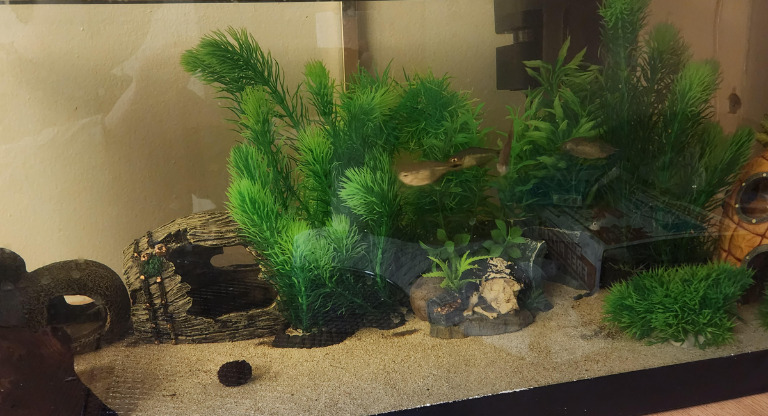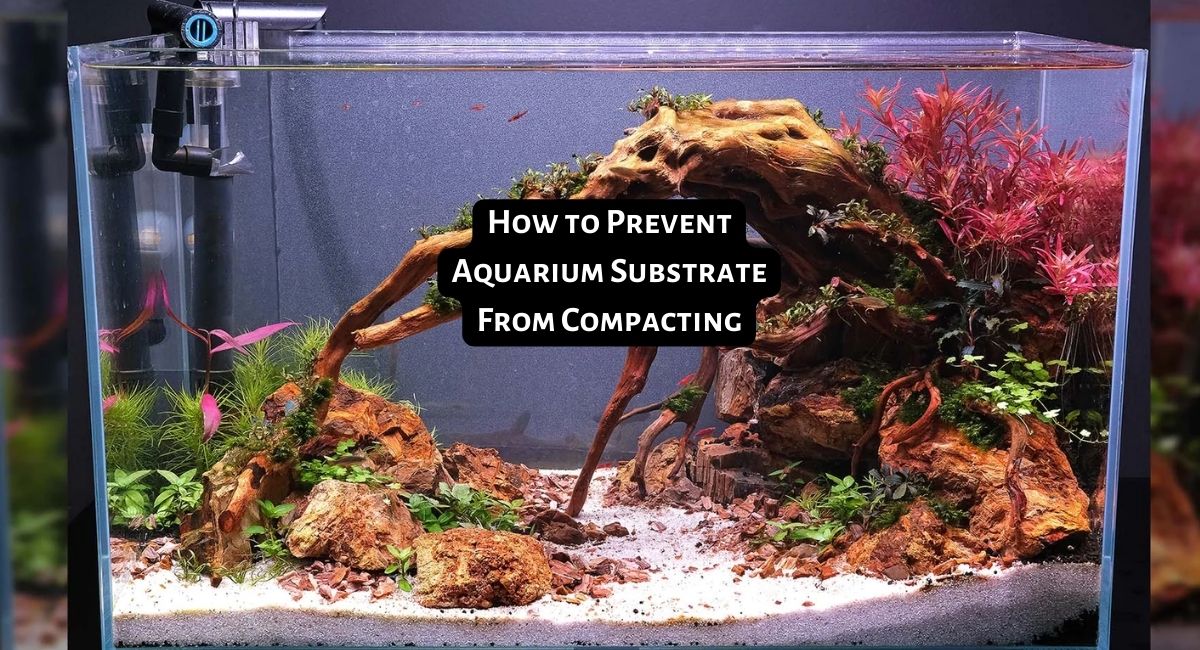Smartplantedaquarium.com participates in affiliate marketing programs. We may earn commissions on purchases made through our affiliate links. This doesn't affect our content or recommendations and we only recommend products we would put in our own tanks.
Substrates provide an essential foundation for your plants and aquatic life, providing nutrients, oxygenation, and bacterial colonization. Choosing the best substrate for your planted tank will depend on a few factors, such as the type of plant you have, the size and shape of your tank, and the types of fish that live there.
We have put together some information to help you decide which substrate is right for you. Read on to learn more about the best substrates for planted aquariums and how to choose the right one for your tank.
Contents
- Key Takeaways
- Best Substrate for Planted Aquariums
- 1. CaribSea Eco-Complete – Best Overall for Planted Tanks
- 2. Seachem Flourite – Best for Rooted Aquatic Plants
- 3. Fluval Plant and Shrimp Stratum – Best for Plants With Larger Root Systems
- 4. Activ-Flora Substrate – Best for Freshwater Planted Tanks
- 5. ADA Aquasoil Amazonia Substrate – Best for Aquascaping
- 6. Mr Aqua Aquarium Soil Substrate – Best Buffering Capacity
- 7. Hermit Habitat Terrarium Substrate – Best for Terrariums
- 8. Tropica Aquarium Soil – Best for Tropical Plants
- 9. Aqueon Plant and Shrimp Substrate – Best Clay Substrate
- 10. Glofish Aquarium Gravel – Best for Creating a Fluorescent Accent
- What to Look for When Buying Planted Aquarium Substrate
- Conclusion
- Frequently Asked Questions
Key Takeaways
- Substrates provide essential nutrients, oxygenation, and bacterial colonization for plants and aquatic life in a planted aquarium.
- The best substrate for your planted tank depends on factors such as plant type, tank size and shape, and types of fish.
- Some popular substrates for planted aquariums include CaribSea Eco-Complete, Seachem Flourite, Fluval Plant and Shrimp Stratum, and Activ-Flora Substrate.
- CaribSea Eco-Complete is praised for its nutrient-rich composition, porous structure, and water clarity maintenance.
- Seachem Flourite is known for its ability to absorb and retain essential nutrients, maintain stable pH, and aesthetic appeal.
- Fluval Plant and Shrimp Stratum creates slightly acidic and soft water conditions, promotes root development, and provides a safe environment for shrimp.
- Activ-Flora Substrate is nutrient-rich, slow-release, and contains beneficial bacteria for plant growth and water quality maintenance.
- It is important to follow proper installation, maintenance, and rinsing instructions for each substrate.
- Substrates can be more expensive than basic substrates, and some may require supplementation over time as nutrients deplete.
- Consider the specific needs of your planted tank when choosing the best substrate for optimal plant and aquatic life health.
Best Substrate for Planted Aquariums
Creating a lush and vibrant planted aquarium is a rewarding endeavor that requires careful consideration of various factors, with the choice of substrate playing a pivotal role. As an avid aquarist who has spent years experimenting with different substrates, I’m here to share my personal insights on the best substrate for planted tanks.
1. CaribSea Eco-Complete – Best Overall for Planted Tanks
CaribSea Eco-Complete Substrate is my top choice when it comes to setting up a planted aquarium. I’ve had my fair share of experiments with different substrates, but CaribSea Eco-Complete has consistently delivered exceptional results, both for my plants and the overall well-being of my aquatic ecosystem.
One of the key features of CaribSea Eco-Complete Substrate is its highly porous spherical grains. These grains provide an ideal environment for beneficial bacteria to thrive, aiding in the rapid conversion of fish waste into nutrients that can be absorbed by the plants. The presence of live Heterotrophic bacteria in the substrate further enhances its waste-digesting capabilities.
The substrate also contains volcanic basalt, which is rich in essential minerals and elements necessary for plant growth and health. These minerals help to support the overall well-being of the plants, ensuring vibrant growth and robust root development. Additionally, the volcanic basalt provides a bi-modal grading system, with fine particles settling at the bottom and coarser particles resting on top. This separation helps to prevent the substrate from compacting, allowing for proper water circulation and root aeration.
One of the benefits of CaribSea Eco-Complete Substrate is its ability to maintain water clarity. Unlike gravel substrates, this planted tank substrate stays cleaner as it does not release any dyes, paints, or coatings that can cloud the water. This ensures that the aquatic environment remains clear and visually appealing, allowing for better observation and enjoyment of the aquarium.
The substrate also offers a visually appealing appearance. Available in different colors, such as black and red, CaribSea Eco-Complete Substrate adds a beautiful contrast to the plants and fish in the aquarium, enhancing the overall aesthetic appeal of the tank.
Based on my personal experience and observations, it’s no wonder that many aquarium enthusiasts share my enthusiasm for CaribSea Eco-Complete Substrate. Its combination of beneficial bacteria, volcanic basalt, and thoughtful design has made it my go-to choice for creating a thriving and visually stunning planted tank.
| Pros | Cons |
|---|---|
| Nutrient-rich, ideal for plant growth. | Can be more expensive than some other substrates. |
| Naturally dark color enhances fish and plant colors. | Some bags might contain fine particles that can cloud water initially. |
| Contains live beneficial bacteria to kickstart the cycling process. | Over time, its nutrient content can deplete and may require supplementation. |
| Does not require rinsing before use. | Particle size might be too coarse for some delicate bottom dwellers. |
| Provides good anchorage for plants. | Some users report inconsistent quality between bags. |
| Porous structure aids in root oxygenation. | pH buffering capacity might not suit all aquarium setups. |
2. Seachem Flourite – Best for Rooted Aquatic Plants
Seachem Flourite is a popular aquarium substrate that is highly regarded among aquarium enthusiasts for its positive impact on plant growth. Made from natural clay, this substrate provides a rich source of essential nutrients for aquatic plants, allowing them to thrive and flourish in a planted aquarium.
One of the key benefits of using Seachem Flourite is its unique composition, which helps to create an optimal environment for plant growth. The substrate is designed to be porous, allowing it to absorb and retain essential nutrients like iron and trace elements. This effectively helps to create a nutrient-rich substrate that can support the healthy growth of aquatic plants.
In addition to its nutrient-holding capabilities, Seachem Flourite also offers other advantages for planted aquariums. The substrate has a slightly acidic pH, which is beneficial for many plant species. It also helps to maintain a stable water chemistry by acting as a natural buffer, preventing pH fluctuations that can be harmful to aquatic life.
Another positive aspect of Seachem Flourite is its aesthetic appeal. It comes in a dark black color, which provides a striking contrast against the vibrant green of aquatic plants. The dark substrate enhances the overall visual appeal of the aquarium, creating a natural and visually appealing environment for both the plants and the fish.
Setting up and maintaining my aquarium with Seachem Flourite has been a breeze. I’ve learned to rinse it thoroughly before adding it to the tank to remove any excess dust or debris. Using a layer of 1-2 inches of substrate, I’ve covered the bottom, creating the ideal foundation for optimal plant growth.
| Pros | Cons |
|---|---|
| Durable, long-lasting substrate with minimal nutrient depletion over time. | Requires thorough rinsing before use to avoid cloudiness. |
| Does not alter pH, making it suitable for a wide range of aquatic setups. | Initially, can cause water cloudiness even after rinsing. |
| Provides good anchorage for plants. | Lacks initial nutrient content, often needing supplementation for heavy root feeders. |
| Aesthetically appealing with a natural appearance. | Can be more expensive than some other substrates. |
| Available in different color varieties. | Might be too sharp for some bottom dwellers like corydoras. |
| Doesn’t break down or decompose over time. | Inert nature means it doesn’t provide as many initial nutrients as some other planted substrates. |
3. Fluval Plant and Shrimp Stratum – Best for Plants With Larger Root Systems
Fluval Plant and Shrimp Stratum has become my go-to substrate choice for my planted aquariums, especially those housing shrimp. I’ve had my fair share of experiences with substrates, but this one, based on my personal use, stands out for its exceptional benefits for both plants and shrimp.
One of the key features of Fluval Plant and Shrimp Stratum is its ability to create slightly acidic and soft water conditions, which is preferred by many shrimp and plant species. This substrate helps to maintain a stable pH level and provides essential minerals and nutrients that promote healthy plant growth. Additionally, it acts as a buffering agent, preventing drastic fluctuations in water parameters and creating a more stable environment for both plants and shrimp.
Another advantage of Fluval Plant and Shrimp Stratum is its ability to promote root development and nutrient uptake. The small granules of the substrate allow plant roots to penetrate easily, establishing a strong root system that supports healthy growth and nutrient absorption. This leads to vibrant and lush plant growth in the aquarium.
When it comes to shrimp, Fluval Plant and Shrimp Stratum provides a safe and suitable substrate for these delicate creatures. The small particle size of the substrate prevents shrimp from getting trapped or injured, while also offering them hiding spaces and surfaces to graze on for food. The natural color of the substrate enhances the overall appearance of the aquarium and complements the colors of the shrimp.
It is worth noting that Fluval Plant and Shrimp Stratum may require rinsing before use to remove any excess dust or debris. However, once properly prepared and added to the aquarium, it offers long-lasting benefits. With proper care and maintenance, Fluval Plant and Shrimp Stratum can last for several years, providing a stable and conducive environment for plant and shrimp life.
| Pros | Cons |
|---|---|
| Specifically formulated for planted tanks and shrimp setups. | Lighter weight can make initial planting a bit challenging. |
| Encourages strong plant root growth due to its porous nature. | Over time, its nutrient content can deplete and may require supplementation. |
| Helps in buffering the water to a slightly acidic pH, beneficial for certain plants and shrimp. | Can break down over time, potentially making the substrate muddy. |
| Contains minerals beneficial for shrimp health. | Can be more expensive than some other substrates. |
| Aesthetically pleasing with a natural, dark appearance. | Some users report inconsistency in granule size between bags. |
| Good for promoting beneficial bacterial growth due to its porous structure. | Might be too light for certain larger or more aggressive fish, leading to uprooted plants. |
4. Activ-Flora Substrate – Best for Freshwater Planted Tanks
Activ-Flora substrate is a specially formulated gravel that is designed for planted aquariums. It provides a nutrient-rich environment for aquatic plants to thrive and grow. With its bio-activ nutrient-enriched composition, Activ-Flora substrate offers many benefits for aquarium enthusiasts.
One of the key features of Activ-Flora substrate is its abundance of trace elements. These trace elements are essential for the healthy growth of plants and can support their nutritional needs. Activ-Flora substrate contains minerals like phosphorous, magnesium, potassium, copper, and zinc, among others. These elements are essential for photosynthesis, root development, and overall plant health.
Another advantage of Activ-Flora substrate is its slow-release nature. The substrate contains micronutrients that are gradually released over time. This slow-release feature ensures that the plants receive a consistent supply of nutrients, minimizing the risk of nutrient deficiencies or excesses. The steady nutrient availability promotes healthy plant growth and vibrant colors.
Activ-Flora substrate also contains live heterotrophic bacteria, which aids in the cycling process of the aquarium. These beneficial bacteria break down organic waste and convert it into plant-available forms, promoting a healthy and balanced aquatic ecosystem. The presence of these bacteria helps to maintain water quality and reduce the risk of harmful pollutants.
In terms of aesthetics, Activ-Flora substrate is available in different colors, such as black and red. These colors can enhance the visual appeal of the aquarium, creating a stunning backdrop for the plants and fish. The substrate’s uniform texture and fine-grained composition give it a sleek and polished appearance.
When using Activ-Flora substrate, it is essential to follow the manufacturer’s instructions for proper installation and maintenance. It is recommended to rinse the substrate before adding it to the aquarium to remove any dust or debris. It is also important to regularly monitor water parameters and perform routine water changes to ensure optimum plant and fish health.
| Pros | Cons |
|---|---|
| Nutrient-rich, promoting healthy plant growth. | May be more expensive compared to basic substrates. |
| Non-toxic and safe for all fish and invertebrates. | Some users report initial cloudiness after setup. |
| Naturally dark color that enhances the appearance of fish and plants. | Over time, nutrient content might deplete, requiring supplementation. |
| Does not alter pH, suitable for various aquatic setups. | Might require thorough rinsing before use to minimize cloudiness. |
| Provides good anchorage for plants. | Inconsistencies in granule size might be observed between bags. |
| Does not compact easily, ensuring good water flow and root penetration. | Being a specific branded substrate, it might not be readily available everywhere. |
5. ADA Aquasoil Amazonia Substrate – Best for Aquascaping
ADA Aqua Soil Amazonia is a substrate that holds a special place in my heart when it comes to planted aquariums. Based on my own experiences, I can confidently say that it’s a top choice for enthusiasts looking to create the perfect environment for aquatic plants to flourish.
One of the key features of ADA Aqua Soil Amazonia is its ability to lower water hardness. This is particularly beneficial for plants that prefer soft water conditions. By reducing the hardness of the water, ADA Aqua Soil Amazonia creates an environment that is more conducive to plant growth.
Another advantage of ADA Aqua Soil Amazonia is its high humic and nutrient content. These nutrients provide essential elements for plant growth, ensuring that plants have access to the necessary resources to thrive. The Amazonia version of this substrate also includes Amazonia Supplement, which enhances the nutrient content even further.
Users of ADA Aqua Soil Amazonia have reported excellent results in terms of plant health and growth. The substrate provides a stable and nutrient-rich base for plants to anchor their roots and absorb nutrients. This promotes robust growth and vibrant colors in aquatic plants.
In addition to its effectiveness in supporting plant growth, ADA Aqua Soil Amazonia is also visually appealing. It has a natural dark color that contrasts well with the green foliage of aquatic plants, creating an aesthetically pleasing display in the aquarium.
When using ADA Aqua Soil Amazonia, it is important to properly prepare and cycle the substrate before introducing plants or fish. Like other soil substrates, ADA Aqua Soil Amazonia can release ammonia during the initial cycling process. It is recommended to monitor the water parameters closely and perform regular water changes to ensure the ammonia levels remain safe for fish.
| Pros | Cons |
|---|---|
| Highly nutrient-rich, ideal for most aquatic plants. | Initial ammonia spike after setup may require cycling before adding livestock. |
| Helps in buffering the water to a slightly acidic pH, which is beneficial for many tropical fish and plants. | Tends to be more expensive than many other substrates. |
| Granular nature provides excellent anchorage for plant roots. | Can break down over time, potentially making the substrate muddy. |
| Aesthetically pleasing with a natural appearance. | Depletes over time and may require nutrient supplementation. |
| Promotes the growth of beneficial bacteria. | Some users find it affects water clarity initially due to leaching of tannins and organic compounds. |
| Widely recognized and used by professional aquascapers. | Might lower the pH too much for certain fish or invertebrate species. |
6. Mr Aqua Aquarium Soil Substrate – Best Buffering Capacity
As a dedicated aquarist and plant enthusiast, I’ve found Mr. Aqua Aquarium Soil substrate to be an exceptional choice for nurturing a thriving planted tank. Based on my own experiences, this substrate stands out for its ability to provide essential nutrients and robust support for aquatic plants, resulting in healthy growth and vibrant colors.
The Mr. Aqua Aquarium Soil substrate is made using soil from Japan, which is kiln-fired with other elements to create a solid and nutrient-rich substrate. The porous granular structure of this substrate helps plant roots penetrate and absorb the necessary nutrients for their growth. It also provides buffering capacities and helps stabilize the pH level of the water within the optimal range for aquatic plants.
One of the key benefits of using Mr. Aqua Aquarium Soil substrate is its long-lasting nature. It can provide essential nutrients to plants for up to 12-18 months, reducing the need for frequent reapplication or supplementation. This not only makes it convenient for aquarists but also helps promote a stable and balanced ecosystem in the tank.
Another advantage of Mr. Aqua Aquarium Soil substrate is its ability to purify water that may be stained from driftwood tannins. It helps remove the discoloration and improves the overall clarity of the water, creating a visually appealing and natural-looking tank.
When using Mr. Aqua Aquarium Soil substrate, it’s essential to properly prepare and install it in the tank. This may involve rinsing the substrate thoroughly to remove any excess dust or sediment before adding it to the tank. It is also recommended to layer the substrate to create a gradient, with a thicker layer at the bottom for root development and a thinner layer on top for a more aesthetically pleasing appearance.
| Pros | Cons |
|---|---|
| Specifically formulated to support plant growth with rich nutrients. | May experience an initial ammonia spike, requiring the tank to cycle before adding fish. |
| Granular nature ensures good anchorage for plant roots. | Over time, the substrate can break down, leading to muddiness. |
| Helps buffer the water to a slightly acidic pH, beneficial for many tropical fish and shrimp. | Might be more costly than some other substrates. |
| Aesthetically pleasing with a dark, natural appearance. | Depending on the batch, there might be some inconsistency in granule size. |
| Suitable for both freshwater planted tanks and shrimp tanks. | Nutrients can deplete over time, necessitating supplementation. |
| Promotes beneficial bacteria growth. | Some users report initial cloudiness in the water after setup. |
7. Hermit Habitat Terrarium Substrate – Best for Terrariums

Hermit Habitat Terrarium Substrate is a popular choice for creating a suitable environment for hermit crabs in captivity. This substrate is specifically designed to mimic the natural environment of hermit crabs, providing them with the necessary conditions for burrowing, molting, and overall well-being.
One key feature of Hermit Habitat Terrarium Substrate is its composition. It is a mixture of sand and coconut fiber, with a ratio of 1 part coconut fiber to 4-5 parts clean play sand. This combination creates an ideal texture and moisture level for hermit crabs. The sand mimics their natural coastal habitats, while the coconut fiber helps to maintain moisture and humidity in the terrarium.
Hermit Habitat Terrarium Substrate is designed to be safe and non-toxic for hermit crabs. It is important to choose a substrate that is free of chemicals, pesticides, and other harmful substances that could be detrimental to the health of the hermit crabs.
This substrate provides a comfortable and stable surface for hermit crabs to walk, dig, and molt. It allows them to exhibit their natural behaviors, such as burrowing into the substrate to molt or create hiding spots. The texture and moisture retention properties of the substrate also help to support the health of their exoskeletons during the molting process.
In addition to providing a suitable substrate for hermit crabs, it is also important to create a proper habitat for them. This includes providing appropriate food, water, shelters, and temperature and humidity levels. The Hermit Habitat Terrarium Substrate can help to maintain the necessary humidity levels in the terrarium, which is crucial for the health and well-being of hermit crabs.
To set up a terrarium with the Hermit Habitat Terrarium Substrate, start by creating a layer of the substrate at the bottom of the tank. The recommended thickness is about 4-6 inches to allow for burrowing. Make sure to mist the substrate with water to achieve the desired level of moisture. Monitor the humidity levels regularly and adjust as needed by adding or removing substrate or misting with water.
It is important to clean and replace the substrate regularly to maintain the cleanliness of the terrarium and prevent the buildup of waste and bacteria. Remove any uneaten food, feces, and other debris from the substrate to prevent odors and potential health issues.
| Pros | Cons |
|---|---|
| Specifically formulated for hermit crab enclosures. | Not suitable for other types of terrarium inhabitants, like reptiles. |
| Helps maintain the right humidity level essential for hermit crabs. | May need regular misting or moisture maintenance to retain optimal humidity. |
| Provides a natural and comfortable burrowing environment for hermit crabs. | Can become moldy if it stays too wet or isn’t cleaned regularly. |
| Often made from coconut fiber, making it eco-friendly and biodegradable. | Some brands might contain added dyes or chemicals. It’s crucial to choose a natural, untreated version. |
| Easy to clean and replace. | Over time, it can break down and become dusty. |
| Can help in reducing odors in the terrarium. | Might be more expensive than some basic substrates like sand or coconut coir alone. |
8. Tropica Aquarium Soil – Best for Tropical Plants
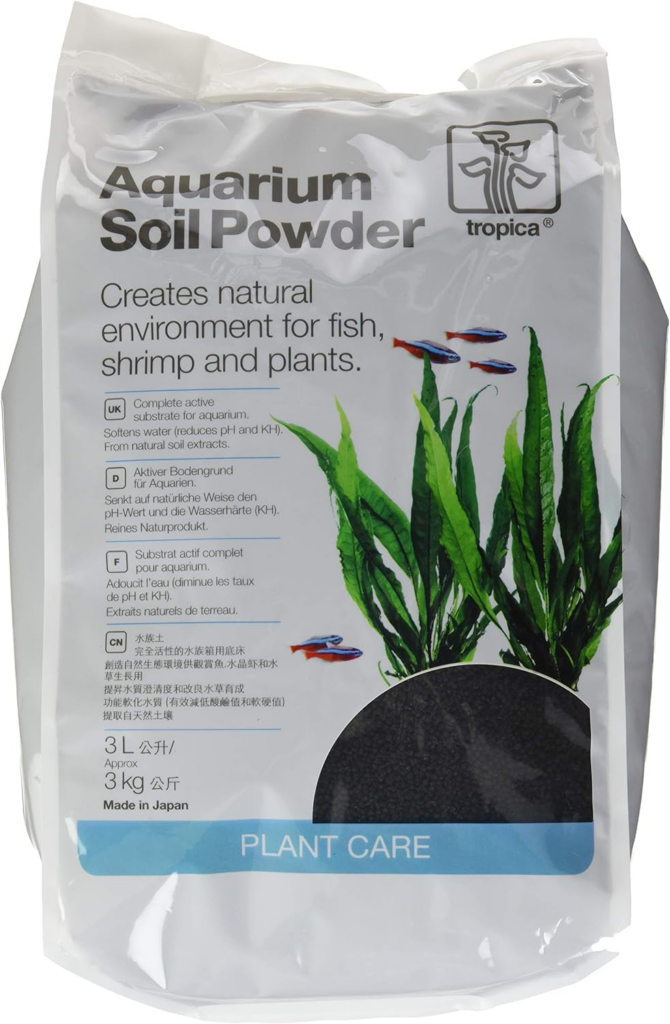
Tropica Aquarium Soil is a complete substrate that provides essential nutrients to support the growth of aquatic plants. It contains a balanced mix of macronutrients and micronutrients, ensuring plants receive the necessary elements for healthy development.
This substrate has the capability to lower the pH value of aquarium water, creating an ideal environment for acid-loving plants. The pH-lowering effect helps to mimic natural conditions and promotes the growth of certain aquatic species.
Tropica Aquarium Soil acts as an active bottom layer, which means it actively releases nutrients into the water column over time. This sustained nutrient release helps to provide a continuous supply of essential elements for plant growth.
The substrate has been specifically designed to enhance the colors of aquarium plants. It contains ingredients that stimulate red plant shades, resulting in visually appealing and vibrant aquatic landscapes.
User reviews of Tropica Aquarium Soil have been generally positive, with many hobbyists reporting enhanced plant growth and improved vitality. The substrate is often praised for its ability to stimulate the growth of demanding plant species, including carpeting plants and vibrant red varieties. Additionally, users appreciate the substrate’s granular texture, which makes it easy to plant and maintain.
Some users have also noted that Tropica Aquarium Soil can slightly cloud the water during initial setup. However, this is a temporary effect and usually clears up within a few days. The overall consensus among aquarists is that the benefits of this substrate outweigh any minor inconveniences.
| Pros | Cons |
|---|---|
| Nutrient-rich, promoting healthy plant growth. | May cause an initial ammonia spike, requiring cycling before introducing livestock. |
| Helps in buffering the water to a slightly acidic pH, beneficial for many tropical fish and plants. | Can be more expensive than some other substrates. |
| Granular nature provides excellent anchorage for plant roots. | Over time, the substrate can break down, leading to muddiness. |
| Enhances the color and appearance of both plants and fish due to its dark color. | Depletes over time and may require nutrient supplementation. |
| Suitable for both beginner and advanced aquarists. | Might lower the pH too much for certain fish or invertebrate species. |
| Does not require a capping layer. | Some users might experience initial cloudiness after setup. |
9. Aqueon Plant and Shrimp Substrate – Best Clay Substrate
The Aqueon Plant and Shrimp Substrate is specifically designed for freshwater aquatic environments. Made from a clay-based material, it has a unique spherical shape that promotes the growth of plants and provides an ideal habitat for shrimp. The substrate is known for its ease of use, ability to support plant growth, and its compatibility with neocaridina shrimp.
One of the standout features of this substrate is its easy maintenance. When adding water to the tank, users have reported zero dust, even after rinsing the substrate. This is a highly desirable quality, as excessive dust can cloud the water and create a less than ideal environment for the inhabitants of the tank. The absence of dust during the initial setup and subsequent water changes is a major plus point for aquarists.
In terms of plant growth, the Aqueon Plant and Shrimp Substrate has proven to be highly effective. It provides a nutrient-rich environment that allows plants to establish strong roots and thrive. Many aquarists have reported improved growth rates and healthier overall plants when using this substrate.
Another notable aspect of this substrate is its compatibility with neocaridina shrimp. Neocaridina shrimp, such as cherry shrimp, require a substrate that won’t adversely affect their health or coloration. The Aqueon substrate has received positive feedback from shrimp keepers, with no reports of adverse effects on shrimp health or coloration. This makes it a suitable choice for aquarists who want to keep a vibrant and healthy shrimp colony.
Furthermore, the Aqueon Plant and Shrimp Substrate also provides a visually pleasing appearance in the tank. Its clay-based material has a beaded shape and a slight shine, adding an attractive decorative element to the aquarium. This can enhance the overall aesthetics of the tank and create a more visually appealing display.
| Pros | Cons |
|---|---|
| Specifically formulated for planted tanks and shrimp setups. | Lighter weight might make initial planting somewhat challenging. |
| Encourages strong plant root growth due to its granular nature. | Over time, its nutrient content may deplete, requiring supplementation. |
| Helps in buffering the water to a slightly acidic pH, beneficial for certain plants and shrimp. | Some users report inconsistency in particle size between bags. |
| Made from natural materials, often mineral-rich clay. | Might be more expensive than some basic substrates. |
| Suitable for both freshwater planted tanks and shrimp tanks. | Some users might experience initial cloudiness in the water after setup. |
| Does not impact water clarity once settled. | May not be as widely available as some other branded substrates. |
10. Glofish Aquarium Gravel – Best for Creating a Fluorescent Accent
Available on popular online platforms like Amazon, Glofish Aquarium Gravel adds a vibrant and eye-catching touch to your aquarium. Customers highly recommend this gravel for its outstanding features and its ability to transform an aquarium into a captivating display.
Black aquarium gravel is a classic choice that complements almost any tank setup. GloFish offers black gravel with fluorescent properties that give it a visually striking appeal under blue lighting. Customers praise this gravel for its affordability and visual appeal.
For a clean and contemporary look, white aquarium gravel is an ideal choice. This gravel enhances the colors of GloFish and creates an elegant aesthetic. Customers appreciate the versatility and eye-catching appearance of white GloFish gravel.
GloFish also offers gravel in a variety of fluorescent colors. These vibrant options add a pop of color to your aquarium and create an engaging environment for your fish. Customers highlight the unique and mesmerizing effect these colorful gravels have on their tanks.
One important factor to consider when choosing aquarium gravel is its safety for fish. GloFish Aquarium Gravel is specially selected and designed to be safe for fish and plants. It is non-toxic and does not release any harmful substances into the water, ensuring the well-being of your aquatic pets.
Based on customer reviews, GloFish Aquarium Gravel receives positive feedback for its quality, appearance, and value for money. Customers appreciate the gravel’s ability to enhance the visual appeal of their tanks and create a captivating underwater environment. The variety of colors and options available also receive praise from customers, allowing them to customize their aquariums to their preferences.
| Pros | Cons |
|---|---|
| Vibrant colors designed to enhance the fluorescent effects of GloFish under blue light. | Lacks the nutrients found in substrates designed for planted tanks. |
| Safe for both GloFish and other fish species. | The bright colors may not be natural-looking and may not be to everyone’s taste. |
| Provides good anchorage for decorations and some plants. | Might require regular cleaning as debris can be more visible against the bright colors. |
| Suitable for freshwater tanks. | Not ideal for tanks with a natural aesthetic or theme. |
| Non-toxic and does not affect water parameters. | May not be suitable for all bottom-dwelling fish due to its coarser texture. |
| Can be mixed with other substrates to achieve a desired look. | May not be the best choice for heavily planted tanks or those requiring specific substrate nutrients. |
What to Look for When Buying Planted Aquarium Substrate
When buying a substrate for a planted aquarium, several factors come into play to ensure the health and growth of aquatic plants. Here’s what to consider:
- Type of Plants: The substrate’s primary purpose is to provide anchorage and nutrients to your plants. Different plants have varying needs:
- Rooted Plants: These extract most of their nutrients from the substrate. Examples include Amazon swords, cryptocorynes, and Vallisneria. For these plants, a nutrient-dense substrate is crucial.
- Column Feeders: These extract nutrients mainly from the water column. Java ferns, mosses, and many stem plants fall under this category. While they can thrive with inert substrates, they still benefit from a substrate that can anchor their roots.
- Nutrient Content: Essential plant nutrients include macro and micronutrients. Good substrates will either contain these nutrients or have the capacity to absorb and release them effectively.
- Macronutrients: Nitrogen (N), Phosphorus (P), Potassium (K), Calcium (Ca), Magnesium (Mg), and Sulfur (S).
- Micronutrients: Iron (Fe), Manganese (Mn), Zinc (Zn), Copper (Cu), Boron (B), Molybdenum (Mo), and Chlorine (Cl).
- Particle Size: A middle-ground option often works best, providing a balance of anchorage and water flow.
- Fine Substrates (like sand): While excellent for anchorage, they can compact, potentially causing anaerobic zones, which are harmful and can produce toxic gases.
- Coarser Substrates (like gravel): Allow for better water flow, which helps reduce the risk of harmful anaerobic pockets. However, smaller plants might have difficulty rooting in them.
- Buffering Capacity: Some substrates can stabilize the water’s pH, which is particularly beneficial in tanks with fluctuating pH levels or in setups desiring specific pH levels, such as those with certain shrimp species.
- Longevity: Over time, nutrient-rich substrates can get depleted. Some substrates may last a year, while others can remain nutrient-rich for several years. After depletion, you might need to add root tabs or replace the substrate entirely.
- Color and Aesthetics: Dark substrates can make both plants and fish colors appear more vibrant. The substrate’s appearance can significantly affect the overall look of the aquarium, so choose one that complements your design vision.
- Inert vs. Active:
- Inert Substrates: Won’t impact your tank’s water chemistry. While they don’t provide nutrients, they can still be used in planted tanks with proper supplementation.
- Active Substrates: These can alter water parameters, usually lowering the pH. They’re often loaded with nutrients beneficial for plants. However, they might not be suitable for all fish or invertebrate species due to the pH changes.
- Cost: Premium substrates can be expensive, but they often come with the advantage of being packed with nutrients. However, there are more affordable options that, when used with root tabs or liquid fertilizers, can still yield excellent results.
- Dust and Cloudiness: Some substrates are notorious for clouding water upon initial setup. It’s often a temporary issue, but it can be reduced or avoided by rinsing the substrate thoroughly before use or using a water clarifier.
- Compatibility with Livestock: Some fish and invertebrates are sensitive to the substrate type. For instance, corydoras prefer soft sand, as coarse substrates can damage their delicate barbels.
- Ease of Planting: A substrate that’s too loose or too fine might not hold plants securely, especially during initial planting. It can be frustrating when plants continually uproot.
- Reviews and Recommendations: Fellow hobbyists and aquarists can provide valuable insights. Online forums, local fish stores, and aquarium clubs are excellent places to gather information and feedback about different substrates.
Conclusion
Choosing the right substrate for your planted aquarium is crucial to ensure the health and growth of your aquatic plants. From our discussion, we learned that there are various types of substrates available, each with its unique characteristics and benefits.
When it comes to selecting the best substrate for your planted aquarium, consider the type of plants you have, their nutrient requirements, and your personal preferences. You can choose from the popular options like gravel, sand, and soil, or even try specialized substrates like aqua soil and clay.
Remember, a good substrate not only supports the growth of your plants but also contributes to the overall aesthetic appeal of your aquarium. So, take the time to research and experiment with different types of substrates until you find the one that works best for your planted aquarium.
Frequently Asked Questions
1. Do planted aquariums need special substrate?
Yes, planted aquariums need special substrate. Substrate affects the health of your aquarium plants and can play an important role in creating a thriving environment for them. Aquarium substrates designed for planted tanks contain nutrients that help to provide food for the roots of plants, as well as maintain pH balance and support beneficial bacteria which are essential for maintaining a healthy aquatic ecosystem. Substrate also helps to anchor plants, allowing their roots to spread out and grow. The right substrate can provide the perfect environment for plant growth in your aquarium.
2. Is sand or gravel better for aquarium?
The best substrate for planted aquariums depends on your specific setup and needs. In general, sand is more suitable for small aquariums with low flow rate and slow-growing plants because it does not disturb the delicate root systems of the plants. Gravel is better for larger tanks and can help create a more vibrant aquatic environment due to its greater surface area. Additionally, some fish species prefer gravel over sand and can experience health problems if kept on sand substrates.
3. What is the best substrate for low tech planted aquarium?
The best substrate for a low tech planted aquarium is one composed of nutrient-rich, soil-like material such as laterite or clay. These substrates have excellent water retention properties, allowing for more oxygen in the root zone and better plant growth, while also providing essential minerals to help nourish your plants. Additionally, these substrates can be layered with inert gravel or sand to provide additional drainage, if desired. Overall, these soil-like substrates are the best choice for low tech planted aquariums, as they ensure optimal growing conditions and health of your plants.
4. How long does planted tank substrate last?
The longevity of a planted tank substrate varies depending on its type and composition. Nutrient-rich substrates like ADA Aquasoil or Fluval Stratum may start to deplete in nutrients after 1-2 years, requiring supplementation through root tabs or liquid fertilizers. Inert substrates like sand or gravel do not provide nutrients to begin with, so they can last indefinitely in the tank, but plants in such substrates will often require supplementation from the start. Some substrates may also break down physically over time, turning muddy after several years, which might necessitate a substrate change. Regular monitoring of plant health and water parameters can help determine when the substrate needs supplementation or replacement.
5. How deep should substrate be in planted aquarium?
The depth of substrate in a planted aquarium largely depends on the type of plants you intend to keep. For most aquatic plants, a substrate depth of 2-3 inches (5-7.5 cm) is sufficient to anchor plants and allow for root growth. However, for heavy root feeders or plants that send out extensive root systems, you might consider a slightly deeper substrate of 3-4 inches (7.5-10 cm). If your tank design includes slopes or hills, you’ll need to adjust the depth accordingly. It’s essential to ensure that the substrate isn’t too shallow, preventing plants from anchoring, or too deep, which can lead to anaerobic pockets that produce harmful gases.
